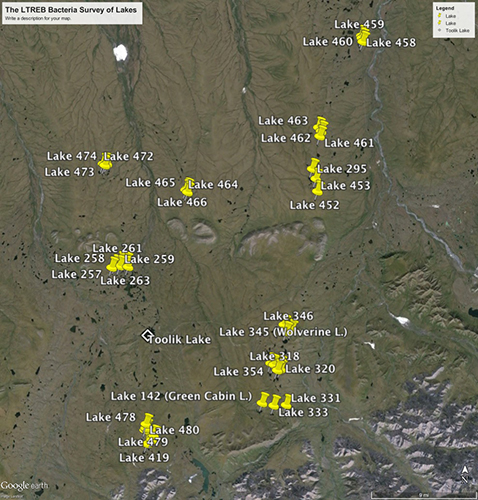 Bacteria Surveys Map. Photo courtesy of Dr. Byron Crump
Bacteria Surveys Map. Photo courtesy of Dr. Byron Crump
The bacteria survey is a two-day survey of 36 lakes in the Arctic Tundra.
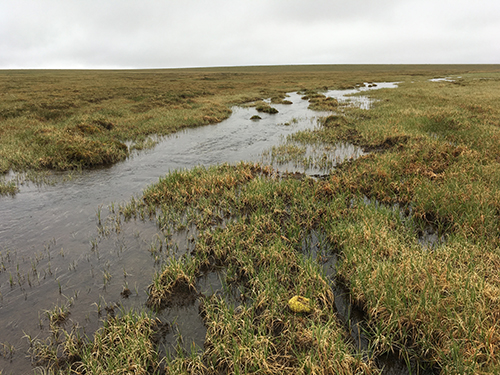 Inlet to Wolverine Lake. Photo by DJ Kast
Inlet to Wolverine Lake. Photo by DJ Kast
The samples are collected from sets of six lakes and collected while the helicopter is running hot, which means that the helicopter doesn't turn off when we sample.
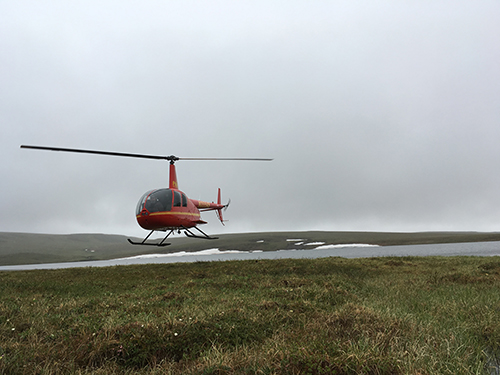 Flying to Wolverine Lake for Day 1. Photo by DJ Kast
Flying to Wolverine Lake for Day 1. Photo by DJ Kast
We spent about 10 minutes at each site on each day and after 20 samples were collected and brought back to Toolik Field Station to process in lab.
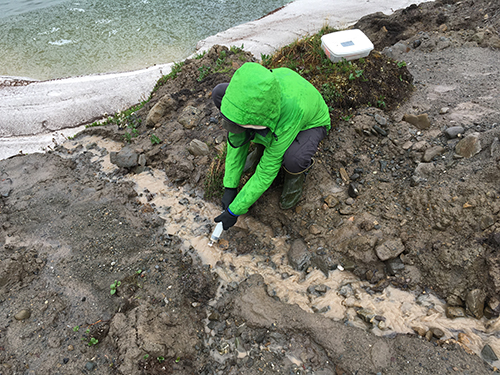 Collecting slump water in the stream near the thermokarst failure near lake. Photo by DJ Kast
Collecting slump water in the stream near the thermokarst failure near lake. Photo by DJ Kast
One the first day, I went with Jason D. and Chris Cook to Wolverine Lake while Johanne A, Graham S. and Dr. Crump went to other lakes on Day 1.
 Wolverine Lake. Photo by DJ Kast
Wolverine Lake. Photo by DJ Kast
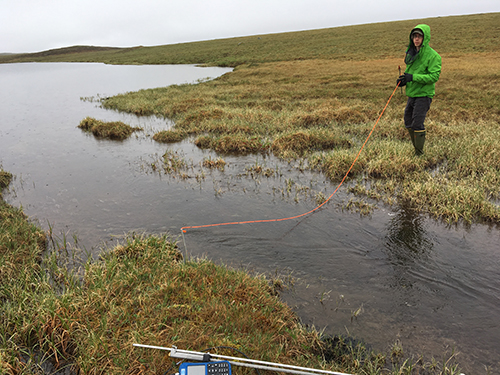 Stream discharge of Wolverine Lake. Photo by DJ Kast
Stream discharge of Wolverine Lake. Photo by DJ Kast
All of these lakes are within 6-20 miles away from Toolik so we needed our helicopter pilot Keaton Molt. This is the ninth recorded year of the bacterial surveys so they have nearly a decade worth of data on these lakes and can observe the changing patterns within them.
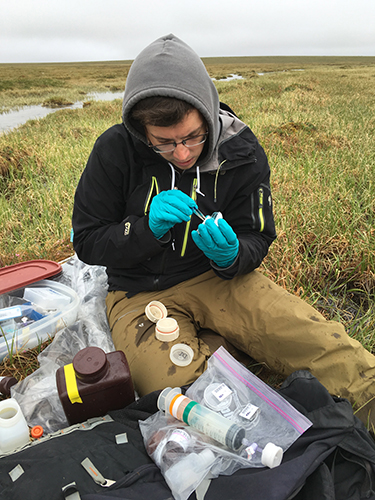 Jason Dobkowski performing his chemistry measurements at the Inlet to Wolverine Lake. Photo by DJ Kast
Jason Dobkowski performing his chemistry measurements at the Inlet to Wolverine Lake. Photo by DJ Kast
 Jason Dobkowski filtering for chemistry! Photo by DJ Kast
Jason Dobkowski filtering for chemistry! Photo by DJ Kast
Wolverine Lake is fascinating because there is a thermokarst failure in the area. As melting progresses in the Arctic, large holes and landslides have popped up across the tundra. In permafrost, ice holds up the soil; when the ice melts, the land surface slumps, creating features known as thermokarst failures and they dump a lot of nutrients into the nearby lakes.
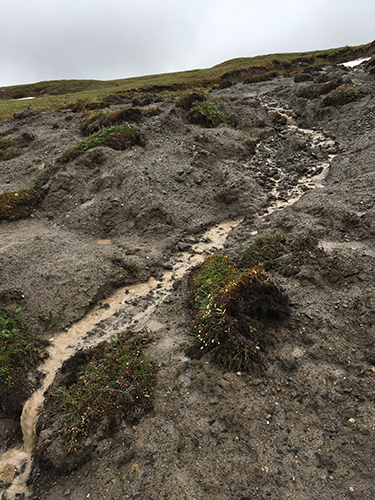 Thermokarst slump. Photo by DJ Kast
Thermokarst slump. Photo by DJ Kast
This lake is particularly crucial because they have data from the lake before the thermokarst failure started dumping into the lake.
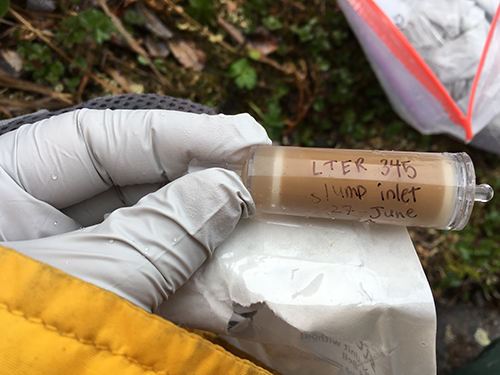 The DNA Sterivex filter of the slump water near Wolverine Lake. Photo by DJ Kast
The DNA Sterivex filter of the slump water near Wolverine Lake. Photo by DJ Kast
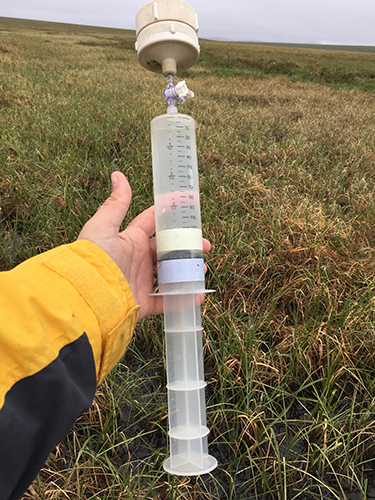 Filtering for chemistry with Jason and Chris. Photo by DJ Kast
Sets of Lakes
Filtering for chemistry with Jason and Chris. Photo by DJ Kast
Sets of Lakes
Lakes
Conflict Lakes (472, 473, 474) Airstrip Lakes (Lakes 416, 417, 419, 478, 479, 480) Escher Lakes (464, 465, 466) Slope Mountain Lakes (Lakes 295, 452, 453) Campsite Lakes (345, 346, 347, 353, 354, 355) Green Cabin Lakes (142, 331, 333) Itigaknit Lakes (257, 258, 259, 261, 262, 263) Wolverine Lake
Day 2“Hot sampling”
- Get out of helicopter and walk away at a 45-degree angle from the nose of the helicopter so that the pilot can see you the whole time. Make eye contact with pilot before walking away to get the thumbs up.
- Find a clear spot at or close to the outlet of the lake
- Put pH and conductivity/temperature probes in the water being sure the ends are not up against vegetation or sitting in the sediment.
- One person (gasser) collects and processes DIC sample a. Find patch of water free of resuspended particles (walk out into lake if possible) b. Triple rinse syringe and collect bubble-free water sample
- Second person (water collector) collects water samples a. Find patch of water free of resuspended particles (walk out into lake if possible, move locations between rinsing and sampling), avoid areas where other two people are sampling b. Triple rinse two 2L bottles (do not use water off the surface layer, i.e., dip mouth below surface). c. Fill bottles (again, do not use water from the surface layer)
- Third person (meter reader and recorder) Record time in notebook. a. Gently place pH probe in water, not directly on a rock or plant b. If there is an error bar, turn off meter and then turn back on, if you decide to switch the probe, you must recalibrate. c. Record conductivity and temperature. d. Aid gasser by preparing syringes (open and flush 3 times) e. Record values and GAS/DIC syringe numbers (gas syringe should be lower number) and aid as needed. f. Record pH value, meter should be reading “READY”
- Move to an area in front of the helicopter well outside the rotor area at a 45degree angle to the nose of the helicopter, make eye contact with the pilot and watch for a signal to return to the helicopter, bend down a little, and then approach the helicopter at a 45degree angle to the nose of the helicopter so the pilot can see you the whole time.
Sample processing 1. Land and wait until the helicopter stops completely, or use hot loading procedures 2. Unload supplies 3. One person processes DNA samples 4. Two people process chemistry samples 5. Reload helicopter and continue survey
Packing List: Chris Cook filtering for chemistry! Photo by DJ Kast
Chris Cook filtering for chemistry! Photo by DJ Kast
• LTREB field notebook w/ pencil • Waders for water collector • 18x 2L brown bottles packed in 3 milk crates (chem. bottles acid washed) 9 marked with red tape for Chemistry, 9 with blue for DNA, all with white tape or duct tape areas for labeling • Car battery in plastic case • Geopump with 3 heads in black case • Battery powered connector for Geopump • Black case containing: o Conductivity/temperature o pH meter • Calibration buffers • Extra pH probe • DIC sampling kit containing: o 45x Gas syringes o 140cc syringe o 60cc syringe o 4x 3-way stopcocks o 2x 1mL syringes o apx 30mL acid (0.2N H2SO4) • Large cooler containing: o 3x Geopump tubing each equipped with 2 luer lock end connectors for 2 sterivex filters o 2x 500mL, 3x 125mL DI Water for rinsing Swinnex and bottles o DNA sampling kits: • 2x GP Sterivex filters • 6x 10ml sterile plastic pipettes • 40x Luer plugs • Cha-seal • DEB in 60cc syringe with 0.2um syringe filter and 3-way luer connector • DEB tube (plastic tube to protect DEB syringe) • Extra tube of DEB • Small cooler with blue ice packs o Chemistry sampling kits • 4x 140ml syringes with 3-way luer connectors (acid washed) • 3x caulking guns • Dark bag for chlorophyll samples • Pre-packed gallon ziplock bags containing water sample bottles, petri plates for filters, etc. • 6x Swinnex filter holders • 2x boxes of 25 each Ashed 25mm diameter GF/F glass fiber filters • 3x forceps
Lab Processing of water samplesDNA
All the field filtering is done in the lab after the samples are brought in. We use the Geopump to be able to do 4 of them at once versus one at a time like we do in the field.
Chemistry.
Why do we do chemical analysis of the waters?
- This research team is studying the elements that control the cycling in the bodies of water. They are the biologically active components of an ecosystem and in this case.
- For example without nitrogen/ phosphorous, there’s no algae, without algae there’s no plankton, no plankton then there’s no fish. You end up with a puddle. Thanks Jason.
- We are looking at the biogeochemical processes that are happening in arctic water systems and how they are changing.
What chemical analysis is being done:
- Nutrients- ammonium and phosphates
- Alkalinity
- Anions (Cl and SO4) and cations (11 different metals)
- Total dissolved phosphate
- DOC- dissolved organic carbon
- TDN- Total dissolved nitrogen
- EEMES- photochem bottle
- Particulate carbon, nitrogen, phosphorus
- Nitrate
- Chlorophyll
The nutrients and the chlorophyll are analyzed here, and the photo bottles are processed here- the rest are shipped back home for more analysis.
There’s a .7 micron filter put onto the syringe and the water is filtered and placed into most of the bottles mentioned above. Then a smaller filter is placed on the syringe to filter for cations.
There are three filters captured for this set of experiments. One is chlorophyll and placed into the drying oven.
YSP Flags In the Field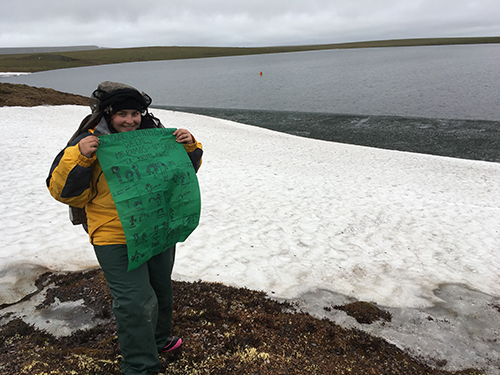 YSP Flag in front of the thermokarst. Photo by DJ Kast
YSP Flag in front of the thermokarst. Photo by DJ Kast
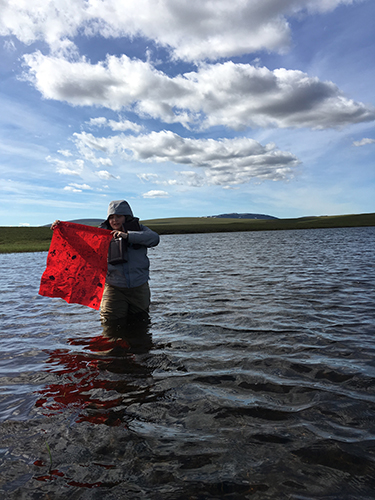 Hirshberg YSP flag. Photo by DJ Kast
Hirshberg YSP flag. Photo by DJ Kast
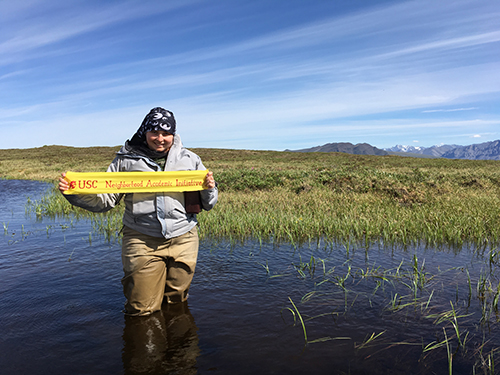 Representing NAI in Lake 418. Photo by DJ Kast
Representing NAI in Lake 418. Photo by DJ Kast
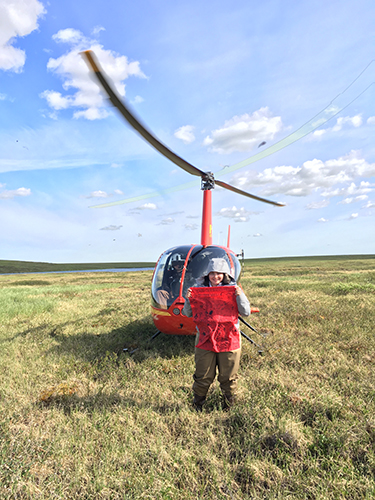 YSP Flag in front of Helicopter. Photo by DJ Kast
YSP Flag in front of Helicopter. Photo by DJ Kast

Comments